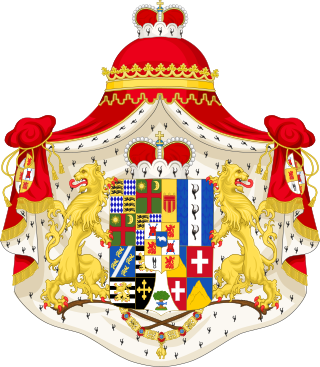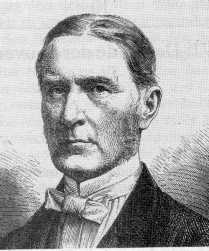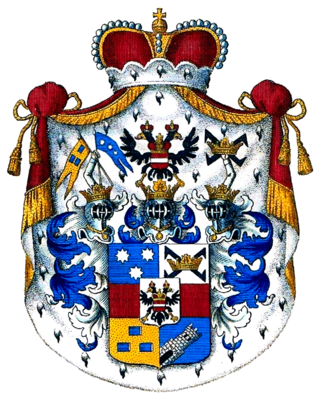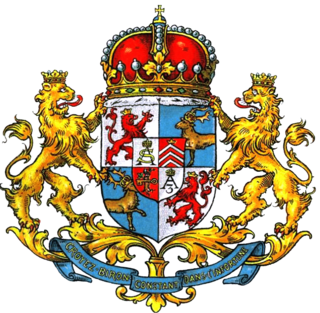
The House of Fugger is a German family that was historically a prominent group of European bankers, members of the fifteenth- and sixteenth-century mercantile patriciate of Augsburg, international mercantile bankers, and venture capitalists. Alongside the Welser family, the Fugger family controlled much of the European economy in the sixteenth century and accumulated enormous wealth. The Fuggers held a near monopoly on the European copper market.

The Princely House of Thurn and Taxis is a family of German nobility that is part of the Briefadel. It was a key player in the postal services in Europe during the 16th century, until the end of the Holy Roman Empire in 1806, and became well known as the owner of breweries and commissioner of several castles. The family has resided in Regensburg since 1748 and have been staying at St. Emmeram Castle from 1803. The family is one of the wealthiest in Germany, and the current head of the House is Albert, 12th Prince of Thurn and Taxis.

Leopold Anton Johann Sigismund Josef Korsinus Ferdinand Graf Berchtold von und zu Ungarschitz, Frättling und Püllütz was an Austro-Hungarian politician, diplomat and statesman who served as Imperial Foreign Minister at the outbreak of World War I.

The House of Fürstenberg is the name of an old and influential Swabian noble house in Germany, based primarily in what is today southern Baden-Württemberg near the source of the Danube river. Numerous members of the family have risen to prominence over the centuries as soldiers, churchmen, diplomats, and academics. Sometimes the name is gallicized as de Furstenberg or anglicized as Furstenberg.
The Solf Circle was an informal gathering of German intellectuals involved in the resistance against Nazi Germany. Most members were arrested and executed after attending a tea party in Berlin on 10 September 1943 at the residence of Elisabeth von Thadden. The group's downfall also ultimately led to the demise of the Abwehr in February 1944.

Johann Philipp, Graf von Cobenzl was a statesman of the Habsburg monarchy and the Austrian Empire.

Arthur Heinrich Ludwig Zarden was a leading personality in German tax legislation and for a short time State Secretary in the Reich Finance Ministry.

The House of Harrach is the name of an old and influential Austro-German noble family, which was also part of Bohemian nobility. The Grafen (Counts) of Harrach were among the most prominent families in the Habsburg Empire. As one of few mediatized families, it belongs to high nobility.

The House of Orsini-Rosenberg is the name of an old Austrian noble family. The family is mediatized and as such belongs to the high nobility. It originally sprang out from the Graben family from Castle Alt-Grabenhofen near the city of Graz.

The House of Khevenhüller is the name of an old and important Carinthian noble family, documented there since 1356, with its ancestral seat at Landskron Castle. In the 16th century, the family split into the two branches of Khevenhüller-Frankenburg, Imperial Counts from 1593, and Khevenhüller-Hochosterwitz, raised to Imperial Counts in 1725 and, as Khevenhüller-Metsch, to princely rank (Fürsten) in 1763. The family belongs to high nobility.

Otto Kamillus Hugo Gabriel Count von Bray-Steinburg was a Bavarian diplomat and politician. He was a son of the diplomat Count François Gabriel von Bray, who was from Rouen, France.

The House of Clary und Aldringen, also known as Clary-Aldringen, is one of the most prominent Austro-Hungarian princely families. Originally from Friuli, Northern Italy, one branch of the family moved to the County of Tyrol around 1500 and to the Kingdom of Bohemia around 1600, where it became one of the leading families of the Bohemian nobility. It produced several notable Austro-Hungarian statesmen, military officers and diplomats.

The House of Urach is a morganatic cadet branch of the formerly royal House of Württemberg. Although the Württemberg dynasty was one of many reigning over small realms in Germany into the 20th century, and despite the fact that marital mésalliances in these dynasties usually disinherited the descendants thereof, the Dukes of Urach unusually managed to elicit consideration for candidacy for the thrones of several European states, viz. the Kingdom of Württemberg, the abortive Kingdom of Lithuania, the Principality of Monaco and even the Principality of Albania. Although none of these prospects came to fruition, they reflected monarchical attempts to accommodate the rapid shifts in national allegiance, regime and international alliances that intensified throughout the 19th century, leading up to and following Europe's Great War of 1914–1918.

The House of Rapperswil respectively Counts of Rapperswil ruled the upper Zürichsee and Seedamm region around Rapperswil and parts of, as of today, Swiss cantons of St. Gallen, Glarus, Zürich and Graubünden when their influence was most extensive around the 1200s until the 1290s. They acted also as Vogt of the most influential Einsiedeln Abbey in the 12th and 13th century, and at least three abbots of Einsiedeln were members of Rapperswil family.

Elisabeth von Rapperswil was the last countess of the House of Rapperswil, and secured by her second marriage the female line of the Counts of Rapperswil and the extensive possessions of Rapperswil in the former Zürichgau to the Laufenburg line. Her son by first marriage was Reichsvogt Wernher von Homberg, and her oldest son by second marriage was Count Johann von Habsburg-Laufenburg who passed over the title of the count of Rapperswil to his oldest son Johann II and his brothers Rudolf and Gotfried.

The House of Biron is the name of the Baltic German aristocratic family which was the ruling family of the Duchy of Courland and Semigallia. The family also enjoyed privileges and influence during the times of the Polish–Lithuanian Commonwealth and in the Russian Empire.

Johanna Susanne Elisabeth Solf was a member of the German resistance to Nazism and the founder of the Solf Circle group of intellectuals, opposed to the Nazi regime.

So'oa'emalelagi Gräfin von Ballestrem was a part of the German resistance to Nazism as a member of the Solf Circle. She was born in Vailima, German Samoa as the daughter of Wilhelm Solf, the German colonial governor, and Hanna Solf. Her Samoan birth name was typically abbreviated to Lagi.
Count Heinrich Julius von Kospoth was a Hessian major general who served in the American Revolutionary War. He was first colonel of the Musketeer Regiment Wutgenau and later as a major general, commanded the First Hessian Division; consisting of the regiments Knyphausen, Ditfurth, Prince Frederick, Bose, Borbeck, Bunau, Benning and Knobloch as well as the Grenadier Battalion Angenelli.
William Maurice II of Isenburg-Philippseich ; was a lieutenant General of the Electorate of Palatinate and the first ruler of the County of Isenburg-Philippseich.


















